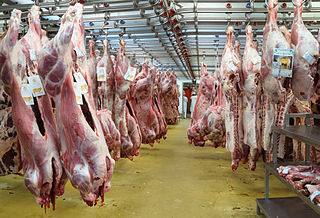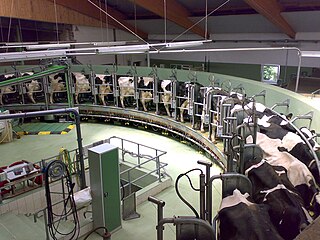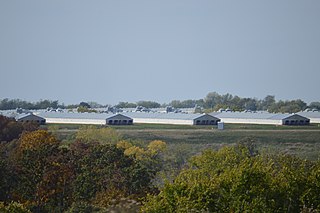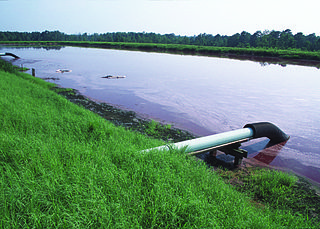
Veal is the meat of calves, in contrast to the beef from older cattle. Veal can be produced from a calf of either sex and any breed; however, most veal comes from young males of dairy breeds which are not used for breeding. Generally, veal is more expensive than beef from older cattle. Veal production is a way to add value to dairy bull calves and to utilize whey solids, a byproduct from the manufacturing of cheese.

Intensive pig farming, also known as pig factory farming is a subset of pig farming and of Industrial animal agriculture, all of which are types of animal husbandry, in which livestock domestic pigs are raised up to slaughter weight. These operations are known as AFO or CAFO in the U.S. In this system of pig production, grower pigs are housed indoors in group-housing or straw-lined sheds, whilst pregnant sows are housed in gestation crates or pens and give birth in farrowing crates.

Dairy farming is a class of agriculture for long-term production of milk, which is processed for eventual sale of a dairy product.

A feedlot or feed yard is a type of animal feeding operation (AFO) which is used in intensive animal farming, notably beef cattle, but also swine, horses, sheep, turkeys, chickens or ducks, prior to slaughter. Large beef feedlots are called concentrated animal feeding operations (CAFO) in the United States and intensive livestock operations (ILOs) or confined feeding operations (CFO) in Canada. They may contain thousands of animals in an array of pens.

In animal husbandry, a concentrated animal feeding operation (CAFO), as defined by the United States Department of Agriculture (USDA), is an intensive animal feeding operation (AFO) in which over 1000 animal units are confined for over 45 days a year. An animal unit is the equivalent of 1000 pounds of "live" animal weight. A thousand animal units equates to 1000 cows, 700 cows used for dairy purposes, 2500 pigs weighing more than 55 pounds (25 kg)s, 125,000 chickens, or 82,000 egg laying hens or pullets.
An anaerobic lagoon or manure lagoon is a man-made outdoor earthen basin filled with animal waste that undergoes anaerobic respiration as part of a system designed to manage and treat refuse created by concentrated animal feeding operations (CAFOs). Anaerobic lagoons are created from a manure slurry, which is washed out from underneath the animal pens and then piped into the lagoon. Sometimes the slurry is placed in an intermediate holding tank under or next to the barns before it is deposited in a lagoon. Once in the lagoon, the manure settles into two layers: a solid or sludge layer and a liquid layer. The manure then undergoes the process of anaerobic respiration, whereby the volatile organic compounds are converted into carbon dioxide and methane. Anaerobic lagoons are usually used to pretreat high strength industrial wastewaters, and municipal wastewaters. This allows for preliminary sedimentation of suspended solids as a pretreatment process.

Intensive animal farming or industrial livestock production, also known by its opponents as factory farming, is a type of intensive agriculture, specifically an approach to animal husbandry designed to maximize production, while minimizing costs. To achieve this, agribusinesses keep livestock such as cattle, poultry, and fish at high stocking densities, at large scale, and using modern machinery, biotechnology, and global trade. The main products of this industry are meat, milk and eggs for human consumption. There are issues regarding whether intensive animal farming is sustainable or ethical.
The environmental impact of meat production varies because of the wide variety of agricultural practices employed around the world. All agricultural practices have been found to have a variety of effects on the environment. Some of the environmental effects that have been associated with meat production are pollution through fossil fuel usage, animal methane, effluent waste, and water and land consumption. Meat is obtained through a variety of methods, including organic farming, free range farming, intensive livestock production, subsistence agriculture, hunting, and fishing.
The concept of an animal unit (AU) has traditionally been used in North America to facilitate planning, analysis and administration of forage use by grazing livestock, but the term has also had other applications. The term has been variously defined by regulation in different jurisdictions, and by livestock management specialists, rangeland resource managers and others. Consequently, when using or interpreting the term, care is needed to ensure that a definition appropriate for the purpose is being used. Most definitions are based on the concept that a 1000-pound (454 kg) cow, with or without an unweaned calf, is one animal unit, with such a cow being assumed to consume 26 pounds of forage dry matter per day.
Comprehensive nutrient management plans (CNMPs) have become an integral part of the regulatory permitting and environmental stewardship for animal feeding operations (AFOs) of all sizes.

Nutrient pollution, a form of water pollution, refers to contamination by excessive inputs of nutrients. It is a primary cause of eutrophication of surface waters, in which excess nutrients, usually nitrogen or phosphorus, stimulate algal growth. Sources of nutrient pollution include surface runoff from farm fields and pastures, discharges from septic tanks and feedlots, and emissions from combustion. Excess nutrients have been summarized as potentially leading to:

Manure management refers to capture, storage, treatment, and utilization of animal manures in an environmentally sustainable manner. It can be retained in various holding facilities. Animal manure can occur in a liquid, slurry, or solid form. It is utilized by distribution on fields in amounts that enrich soils without causing water pollution or unacceptably high levels of nutrient enrichment. Manure management is a component of nutrient management.

Cattle, or cows (female) and bulls (male), are the most common type of large domesticated ungulates. They are a prominent modern member of the subfamily Bovinae, are the most widespread species of the genus Bos, and are most commonly classified collectively as Bos taurus.
Lynn Henning is a farmer and environmentalist from Michigan, United States. She was awarded the Goldman Environmental Prize in 2010 for her focus on water quality and for fighting pollution from concentrated animal feeding facilities. She exposed the polluting practices of livestock factory farms in rural Michigan, gaining the attention of the federal EPA and prompting state regulators to issue hundreds of citations for water quality violations. Henning currently works for the Socially Responsible Agricultural Project (SRAP). She also won the Planet Defender Award 2012 for her advocacy and her work.
Solid waste policy in the United States is aimed at developing and implementing proper mechanisms to effectively manage solid waste. For solid waste policy to be effective, inputs should come from stakeholders, including citizens, businesses, community based-organizations, non governmental organizations, government agencies, universities, and other research organizations. These inputs form the basis of policy frameworks that influence solid waste management decisions. In the United States, the Environmental Protection Agency (EPA) regulates household, industrial, manufacturing, and commercial solid and hazardous wastes under the 1976 Resource Conservation and Recovery Act (RCRA). Effective solid waste management is a cooperative effort involving federal, state, regional, and local entities. Thus, the RCRA's Solid Waste program section D encourages the environmental departments of each state to develop comprehensive plans to manage nonhazardous industrial and municipal solid waste.
Livestock Water Recycling, Inc. (LWR) is a privately owned Canadian company based in Calgary, Alberta. The environmental company focuses on livestock manure management at dairy and hog CAFO livestock operations.
Animal welfare and rights in Canada Canada is about the laws concerning and treatment of nonhuman animals in Canada. Canada has been considered to have weak animal welfare protections by the organization World Animal Protection. The vast majority of Canadians are for further animal protections, according to a poll conducted on behalf of Mercy for Animals.
Environmentally Concerned Citizens of South Central Michigan (ECCSCM) is an association of citizens in Michigan, who are concerned about the consequences of concentrated animal feeding operations (CAFOs). The ECCSCM is located in the Western Lake Erie Watershed.

The environmental impact of pig farming refers to the threats posed to the natural environment by large-scale intensive pig farming. Industrial pig farming, a subset of concentrated animal feeding operations (CAFOs), poses numerous threats to the environment. CAFOs house thousands of swine and other farm animals in confined areas, where feces and waste often spread to surrounding neighborhoods, polluting air and water with toxic waste particles. Waste from these farms have the potential to carry pathogens, bacteria, and heavy metals that can be toxic when ingested. Pig waste also contributes to groundwater pollution in the forms of groundwater seepage and waste spray, which is essentially the usage of a sprinkler to spray vats of pig waste into neighboring areas. The contents in the spray and waste drift have been shown to cause mucosal irritation, respiratory ailment, increased stress, decreased quality of life, and higher blood pressure. This improper way to get rid of waste is an attempt for CAFOs to be cost efficient. This presents an environmental injustice problem, since the communities do not receive any benefit from the operations, and instead, suffer negative externalities, such as pollution and health problems. The Agriculture and Consumer Health Department has stated explicitly that the "main direct environmental impact of pig production is related to the manure produced.
Groundwater pollution, also referred to as groundwater contamination, is not as easily classified as surface water pollution. Groundwater aquifers are susceptible to contamination from sources that may not directly affect surface water bodies.









